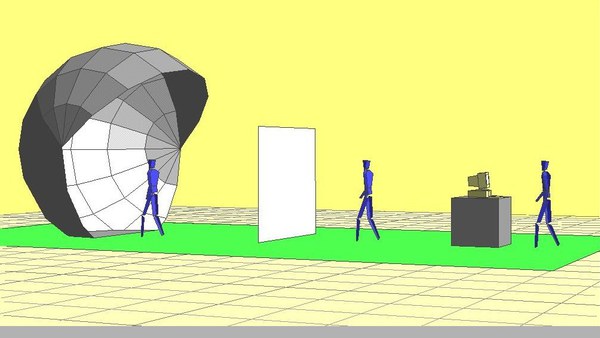Spatial Cognition

An important part of our research on human navigation was conducted in the context of the DFG priority program SPP 1021, “Spatial Cognition”, in which 16 research groups in Germany cooperated.
Our work on virtual reality (VR) began in 1998 with an attempt to combine computer-generated buildings into naturalistic scenes. It soon became clear that the height of objects is perceived differently than their width or depth.
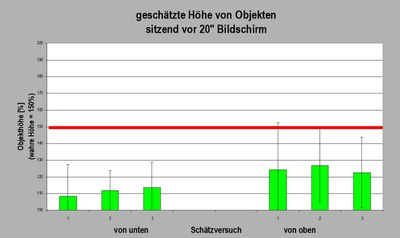
This effect is known as the “Moon illusion.” Our experiments showed that most subjects perceived a building height of about ¾ of the true height to be a realistic presentation.
Literature
Popp, Michael M.: „Darstellung von Breite und Höhe von Gebäuden in VR-Umgebungen“. In: Bülthoff, Heinrich H.; Fahle, Manfred; Gegenfurtner, Karl R.; Mallot, Hanspeter A. (Hrsg.), Beiträge zur 2. Tübinger Wahrnehmungskonferenz, 26.-28.2.1999, Verlag Knirsch, Kirchentellinsfurt. 1999. S. 76.
Development of Spatial Knowledge and Orientation Ability
In a series of progressive field experiments in large urban areas, we examined the development of navigational abilities in children of both sexes. The first experiments were conducted with groups of kindergarten and elementary school children. The children were tested on their route knowledge and survey knowledge after their first contact with unfamiliar terrain. We were especially interested in:
- cognitive mapping,
- landmark characteristics,
- mental spatial models.
Our little test subjects were individually taken on a guided tour of the premises of UniBw M. At different locations, they were asked to point towards the starting point of the tour, which was out of sight, or to indicate the presumed direction towards this starting point on a directional measurement device (see below). After this tour, they were asked if they remembered certain prominent “landmarks” from their walk across the premises. Their manner of perception as well as their navigational abilities were then measured in paper-and-pencil tests. They were asked about their previous experience of finding their way around unknown terrain, with their answers verified by their parents.
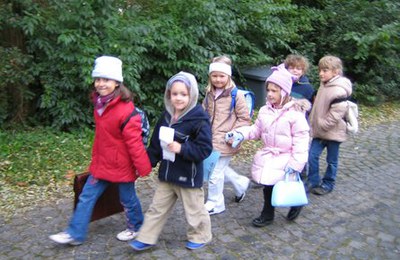
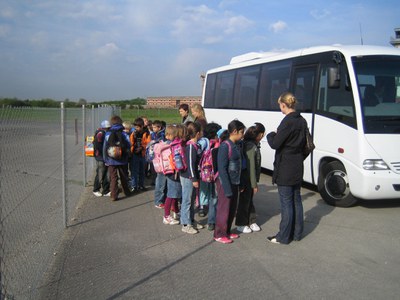
These experiments were conducted once in the reality of our university campus and again in the corresponding virtual reality environment. The virtual reality setup allowed the test subjects to “wander around” the virtual reality environment by simply walking. They could set the direction towards the target by turning the virtual landscape until the indicator in the center of the display pointed towards the target.
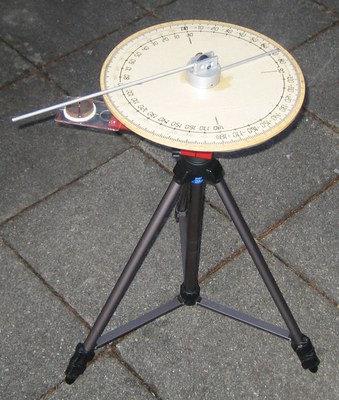
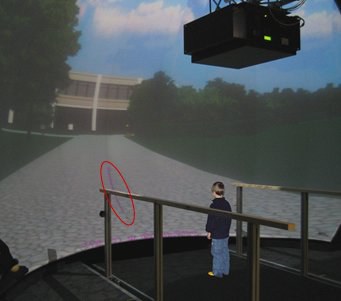
By comparing the results of the children to those of adult subjects, we were able to gradually discover the process of acquiring navigational abilities. It became clear that this is not a continuous process but that, at certain ages, leaps of development occur. This has long been predicted by developmental psychologists. The level of accuracy with which the children pointed towards the starting point in the real world setting did not differ from that of the adult subjects:
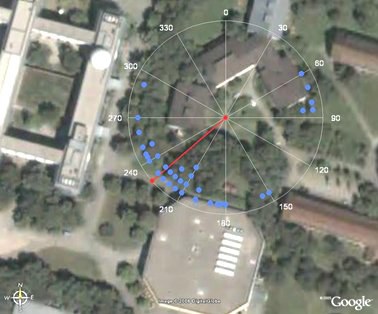
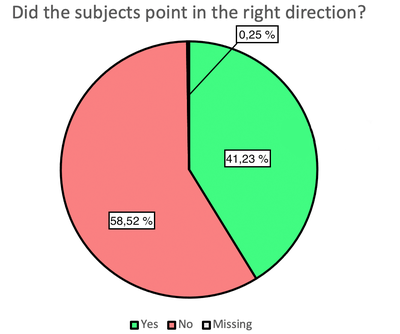
Indicated direction (green) vs. real direction (red) Quality of directing performance
In the virtual reality setting, however, the children fared far worse. This is indicative of the egocentric perspective of our child subjects’ cognitive maps, which is typical of the stage of development of children of that age. Allocentric spatial processing abilities do not develop until young adulthood.
Literature
Neidhardt, Eva; Popp, Michael M.: “Activity Effects on Path Integration Tasks for Children in Different Environments”. In: Stachniss, Cyrill; Schill, Kerstin; Uttal, Davis (Hrsg.): “Spatial Cognition VIII: International Conference, Spatial Cognition2012; Kloster Seeon, Germany; August 31.8.-3.9.2012”; Berlin, Springer, 2012. S. 210-219.
Neidhardt, Eva; Popp, Michael M.: “Spatial Tests, Familarity with the Sourroundings, and Spatial Activity Experience”. In: Journal of Individual Differences, Vol. 31, Verlag Hogrefe. 2010. S. 59-63.
Neidhardt, Eva; Popp, Michael M.: „Barriere-Effekt beim Richtungszeigen in unbekannten navigierbaren Makroräumen“. In: Khader, Patrick; Jost, Kerstin; Lachnit, Harald; Rösler, Frank (Hrsg.): „Beiträge zur 50. Tagung Experimentell arbeitender Psychologen“, Marburg 3.-5.3.2008, Papst Science Publishers, Berlin. 2008. S. 178.
Popp, Michael M.; Neidhardt, Eva: „Spatial Tests and Spatial Activity: How do they Contribute to Spatial Orientation in Familiar Macro Environments?“ In: XXIX International Congress of Psychology; 20.-25.7.2008; Berlin. 2008. No. 58.
Platzer, Edna: „The human navigation process and its comparability in complex real and virtual environments”, Dissertation, Universität der Bundeswehr München, Fakultät für Luft- und Raumfahrttechnik, 2005.
Popp, Michael M.; Platzer, Edna; Eichner, Matthias; Schade, Marion: „Walking with and Without Walking: Perception of Distance in Large-Scale Urban Areas in Reality and in Virtual Reality”. In: Presence: Teleoperators and Virtual Environments, MIT Press, Vol. 13 (1).2004. S. 61-76.
Popp, Michael M.; Platzer, Edna: „Entfernungswahrnehmung in der Realität und in VR“. In: Bülthoff, Heinrich H.; Gegenfurther, Karl R.; Mallot, Hanspeter; Ulrich, Rolf; Wichmann, Felix A. (Hrsg.), Beiträge zur 6. Tübinger Wahrnehmungskonferenz, 21.-23. 2.2003, Verlag Knirsch, Kirchentellinsfurt. 2003. S. 171.
Platzer, Edna; Popp, Michael M.: „Experimente in Virtueller Realität und in der Realität: Wahrnehmung von Distanz und Zeit in Large Scale Urban Areas“. In: Van der Meer, E; Hagendorf, H; Beyer, R; Krüger, F; Nuthmann, A; Schulz, S (Hrsg.), 43. Kongress der Deutschen Gesellschaft für Psychologie, Berlin 22.-26.09.2002, Papst Science Publishers, Berlin. 2002. S, 272.
Schweitzer, Karin; Popp, Michael M.: „Raumkognition und virtuelle Realität“. In: Baumann, Martin K. R.; Krems, Josef (Hrsg.), Experimentelle Psychologie: Abstracts der 44. Tagung experimentell arbeitender Psychologen (TeaP), 25.-27. 3.2002, Chemnitz, Verlag Roderer. 2002. S. 59.
Popp, Michael M.: „Mentale Raumrepräsentationen, Orientierung und Navigation in 'large scale urban areas': Gibt es Geschlechtsunterschiede?“ In: Silbereisen, Rainer K.; Reitzle, M. (Hrsg.) 42. Kongress der Deutschen Gesellschaft für Psychologie in Jena, 24.-28. 9.2000, Papst Science Publishers, Berlin. 2001. S. ###.
Popp, Michael M.: „Mentale Raumpräsentationen, Landmarken und Zeigeverhalten: Zur Qualität von Wegauskünften.“ In: Hacker, Winfried; Rinck, Mieke (Hrsg.), 41. Kongress der Deutschen Gesellschaften für Psychologie, Dresden, 27.9.-1.10.1998.
Popp, Michael M.: “Zeigeverhalten, Landmarken und mentale Raumrepräsentationen.“. In: Bülthoff, Heinrich H.; Fahle, Manfred; Gegenfurtner, Karl R.; Mallot, Hanspeter (Hrsg.), Beiträge zur 1. Tübinger Wahrnehmungskonferenz, 27.2.-1.3.1998, Verlag Knirsch, Kirchentellinsfurt. 1998. S. 73.
Popp, Michael M.: “Navigation in the Unknown, Frames of Reference, Virtual Reality, and the Role of visual Cues in Orientation.“. In: “18th European Conference on Visual Perception, Tübingen, Germany, 21.-25.8.95”, Perception, 24, Supplement. 1995. S. 73.
